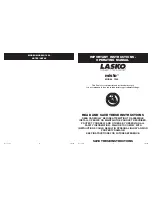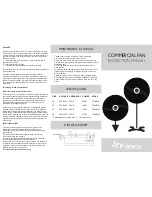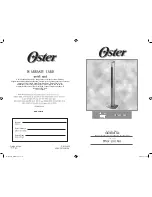
31573808EN-02
16
Alfa LU-VE is a trademark registered and owned by LU-VE Group.
Alfa LU-VE reserves the right to change specifications without prior notification.
6.9 Fan motors connections
The maximum load of the motors and the recommended settings for the overload relays are to be
respected. The built-in thermal overload protection must be integrated in the control circuit when
a connection in the terminal box is present. The electrical control circuit should be arranged with
a manual reset device in order to prevent continuous on/off switching (tripping) of the motors.
Suppliers and manufacturers of electrical motors provide no guarantee for motors that are
combusted through overload.
Ensure complete electrical isolation before performing any wiring.
1~230 V 50-60 Hz
Type
Power supply
Ø
Motor power consumption*
n. of fans
1
2
3
4
EC
1~230 V - 50/60 Hz
275
28 W 0.2 A
56 W 0.4 A
84 W 0.6 A
112 W 0.8 A
* During operation with frost on the fins, the electrical absorption can grow up to 20-30 % more than the nameplate data.
6.10 Defrost
Always refer to the electrical scheme for both connections and nominal voltage of the electrical
defrost option. Earth cable must always be wired and connected to the appropriate terminal in the
connection box. Always refer to the electrical scheme order to identify the ground terminal.
Warning about the neutral wire: it must be connected if indicated in the electrical scheme. It must
not be connected if it is not shown in the electrical scheme.
Coolers without defrosting facilities may not be used in room temperatures below +2
°C.
If the cooler is working on a time termination cycle, it is suggested that an initial defrost period be
set at 35 to 45 minutes (in combination with the number of defrost periods). This setting is to be
refined through trial and error, according to the actual defrost requirements depending on cooler
model, size, and working conditions. If the defrosting cycle is terminated via a temperature sensor,
close attention must be taken in positioning the thermostat sensor. The temperature sensor is
usually set at a value between 10°C and 15°C. In general it should be positioned where the last
traces of frost disappear, usually on the coil.
At room temperatures of around 0°C the last frost is usually in the top of the coil block. At room
temperatures below -20°C, this is the consequence of the so-called 'chimney effect', usually in the
lower half of the coil block at approx. ¼ of the fin height. Unfortunately a number of factors (cooler
position relative to an access door or stored products, precise setting of the thermostatic expansion
valve, etc.) may cause identical coolers to perform differently. Thermostat sensors should NOT be
placed in the direct vicinity of a heater element. The final position of the temperature sensors must
be determined through trial and error.
L N PE PE N L
L N PE PE N L
L N PE PE N L
L N PE PE N L
STANDARD
Содержание ALFA ptigo PF27MC
Страница 24: ...alfa luvegroup com ...









































